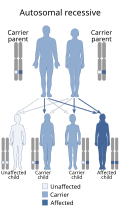Hexokinase deficiency: Difference between revisions
CSV import |
No edit summary |
||
| Line 37: | Line 37: | ||
[[Category:Rare diseases]] | [[Category:Rare diseases]] | ||
{{dictionary-stub1}} | {{dictionary-stub1}} | ||
<gallery> | <gallery> | ||
File:Autosomal_recessive_-_en.svg|Autosomal recessive inheritance pattern | File:Autosomal_recessive_-_en.svg|Autosomal recessive inheritance pattern | ||
</gallery> | </gallery> | ||
Revision as of 23:48, 16 March 2025
Hexokinase deficiency is a rare genetic disorder that affects the body's ability to metabolize glucose, leading to a variety of symptoms including anemia, jaundice, and fatigue. This condition is caused by mutations in the HK1 gene, which provides instructions for making an enzyme called hexokinase.
Causes
Hexokinase deficiency is caused by mutations in the HK1 gene. This gene provides instructions for making an enzyme called hexokinase, which plays a crucial role in the first step of glucose metabolism. Mutations in the HK1 gene reduce the activity of hexokinase, disrupting the normal process of glucose metabolism and leading to the symptoms of hexokinase deficiency.
Symptoms
The symptoms of hexokinase deficiency can vary widely, but they often include:
- Anemia: A condition characterized by a lack of healthy red blood cells, leading to fatigue and weakness.
- Jaundice: A yellowing of the skin and eyes, caused by a buildup of a substance called bilirubin.
- Fatigue: A feeling of tiredness or exhaustion that doesn't go away with rest.
Diagnosis
Diagnosis of hexokinase deficiency typically involves a series of tests, including blood tests to check for anemia and jaundice, and genetic testing to identify mutations in the HK1 gene.
Treatment
Treatment for hexokinase deficiency is typically focused on managing the symptoms of the condition. This can include treatments for anemia and jaundice, as well as lifestyle changes to help manage fatigue.
See also
References
<references />




